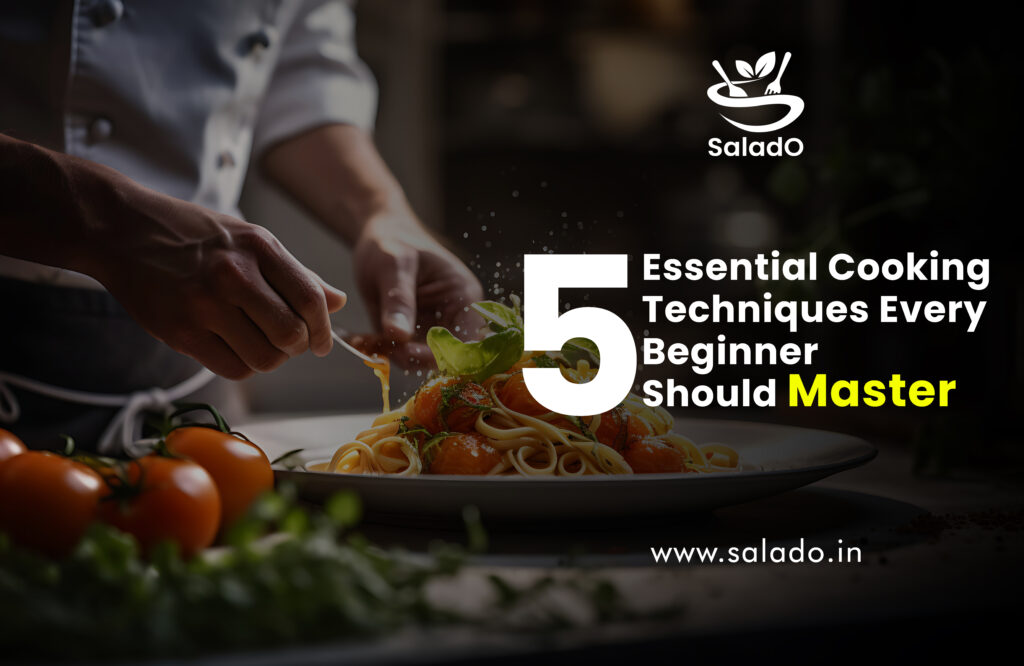
So you want to step up your cooking game and start making restaurant-quality meals at home? We’ve all been there, mixing and matching recipes but never quite achieving the flavors and textures you dreamed of. Well, hold onto your aprons because I’m serving up the 5 must-know cookinSo you want to step up your cooking game and start making restaurant-quality meals at home? We’ve all been there, mixing and matching recipes but never quite achieving the flavors and textures you dreamed of. Well, hold onto your aprons because I’m serving up the 5 must-know cooking techniques that separate the home cooks from the culinary masters. From perfectly pan-searing steaks to the secrets of a silky-smooth risotto, I’m about to drop some kitchen wisdom that will transform your dishes from so-so to absolutely stunning. With these essential skills in your arsenal, you will be the envy of all your dinner guests and maybe even have them begging for the recipes. Let’s get cooking!
Knife Skills – Master the Fundamentals
To become proficient in the kitchen, you’ll need to develop essential knife skills. Handling knives safely and properly cutting ingredients are fundamentals every beginner cook should master.
The first step is choosing a chef’s knife that feels comfortable and balanced in your hand. A 6 to 8-inch knife is a versatile size for most home cooks. Keep your knives sharp using a whetstone or electric sharpener. A sharp knife requires less pressure and is safer to use.
Hold the knife firmly but don’t squeeze the handle. Use a cutting board and work slowly and carefully. Curl your fingers and tuck your thumb under for safety. Practice the claw grip or “bear paw” to guide ingredients.
There are several basic cuts every cook should know:
Dicing: Cutting food into small, uniform cubes. Use for onions, carrots, celery, etc. Make a series of slices, then cut across in the opposite direction.
Mincing: Cutting into very fine pieces. Good for garlic, ginger, herbs. Rocking the knife using a “cross-chopping” motion.
Julienne: Cutting into matchstick-sized pieces. Make thin slices, stack, then cut into strips. Use for carrots, cucumbers, zucchini.
Chiffonade: Delicate strips. Stack leaves, roll tightly, then slice thinly across the roll. Use for basil, spinach, mint.
Slice: Cutting into flat pieces. Use a slicing or carving knife and cutting board for larger items like meat, bread, cheese.
Chop: Cutting into irregular, chunky pieces. Use an up and down “rocking” motion. For onions, veggies, meat, nuts.
Developing essential knife skills takes practice. Focus on safety, hold the knife properly and take your time. With regular practice of these fundamental techniques, you’ll gain confidence in the kitchen and can tackle more advanced recipes. Master these skills and you’ll be slicing and dicing like a pro in no time!
Sautéing – The Most Versatile Cooking Technique
Sautéing is one of the most useful cooking techniques for beginners to master. It’s versatile, quick, and helps you make a variety of delicious dishes. To sauté means to fry food quickly in a little fat over high heat while stirring frequently. Some basics to keep in mind:
Use a heavy pan, like cast iron or stainless steel, with deep sides. This helps the food cook evenly and contains splattering. Add about 1-2 tablespoons of a high-temperature oil with a high smoke point, such as canola, vegetable, peanut or safflower oil. Let the oil heat up before adding the food.
Make sure not to overcrowd the pan. Add pieces of food in a single layer so they have plenty of room to heat through. Overcrowding will steam the food and make it soggy instead of nicely browned. Cook the food in batches if needed, transferring to a platter and covering with foil to keep warm.
Stir the food frequently while it’s cooking using a wooden spoon or spatula. Frequent stirring helps the food cook evenly and prevents burning. For extra browning, let the food sit for 30-60 seconds before stirring.
Season the food with salt and pepper. Add fresh or dried herbs if desired. The food should be lightly browned and crisp-tender when done. Taste a piece to check if it’s cooked through.
Some foods that are perfect for sautéing include:
•Vegetables like bell peppers, broccoli, carrots, mushrooms, zucchini and spinach. Blanch firmer veggies like broccoli and carrots before sautéing.
•Shrimp, scallops, diced chicken, beef and pork. Make sure meat is cut into evenly sized pieces.
•Tofu. Extra-firm tofu works best. Press out excess moisture before sautéing.
•Garlic and shallots. Sauté in butter or oil until golden brown and fragrant.
•Eggs – for scrambled eggs or an omelette. Whisk eggs thoroughly and cook, stirring frequently, until set.
Sautéing is a simple technique but with a little practice you’ll be making healthy and delicious meals in minutes. Experiment with different foods and flavors – the possibilities are endless!
Roasting – Unlock Flavor With Dry Heat
Roasting uses dry heat to transform raw ingredients into richly flavorful meals. Roasting brings out the natural flavors of meat, seafood, vegetables, and more. It’s one of the simplest cooking techniques to master, yet also yields some of the most satisfying results.
To roast food, first preheat your oven to the proper temperature, usually between 350 to 450 F depending on the item. Then, place the food on a rack in a roasting pan so air can circulate all around. Roast, turning once, until the internal temperature reaches the safe temperature for that item.
For meat like chicken, beef, or pork, aim for an internal temp of at least 165 F. Fish should reach 145 F. Vegetables are done when tender and lightly browned. Roasting at higher heat, around 400 F, will yield a browned, crispy exterior, while lower heat around 350 F results in a moister end product.
Some tips for roasting:
Brush or toss meat and veggies in oil and season generously with salt and pepper before roasting. Herbs like rosemary and thyme also pair well.
For extra browning and flavor, roast meat fat side up. The fat will melt and baste the meat as it cooks.
Toss root veggies like potatoes, carrots, and beets in oil and spread on a sheet pan. Roast at 400 F, stirring once, until browned and tender when pierced with a fork.
For whole fish, score the skin by making diagonal slashes about 1 inch apart. This allows fat to render and the fish to cook more evenly.
Let the food rest for 5 to 10 minutes before serving. This allows the juices to redistribute and helps the meat retain moisture.
Roasting may seem simple, but following these tips will have you making flavorful, restaurant-quality meals at home. Once you’ve mastered the basics, experiment by mixing various veggies on one sheet pan or trying different spice rubs on meat. The possibilities are endless.
Baking – Learn the Science of Sweets and Treats
Baking is a science as much as an art. Understanding some fundamentals will help ensure your baked goods turn out perfectly every time.
The first key is having the right ingredients and tools. Make sure you have baking powder, baking soda, salt, sugar, eggs, butter or oil, and milk or cream. You’ll also want measuring cups and spoons, mixing bowls, a stand mixer or hand mixer, spatulas, and of course, pans.
Before you start, bring all ingredients to room temperature. Cold ingredients won’t blend well and can affect how the batter bakes. Preheat your oven and grease pans or line with parchment paper.
Pay close attention to measurements. Baking requires precise amounts of each ingredient for the chemical reactions to work. Level off cups and spoons for accurate measuring. Don’t forget that liquids need to be poured into measuring cups at eye level.
Mix wet and dry ingredients separately, then gently combine them. Overmixing can make baked goods tough. Mix just until the dry ingredients are moistened.
Check for doneness before removing from the oven. A toothpick inserted into the center should come out clean. Browning on top doesn’t always mean it’s done inside. Check a few minutes before the suggested baking time.
Allow baked goods to cool completely on a wire rack before frosting or serving. This gives the structure time to set as it cools.
With some practice, you’ll be whipping up sweet and savory treats like a pro in no time. Baking gives you an opportunity to spread joy through your culinary creations. Follow these fundamentals, be precise in your technique, and most importantly, have fun while you bake!
Grilling
Grilling is one of the most popular cooking techniques for beginners to master. The smoky, charred flavor of grilled food is irresistible. Grilling uses direct, dry heat to quickly cook food, usually over an open flame or hot coals. The intense heat seals in juices and gives food a distinctive grilled texture and flavor.
To get started with grilling, you’ll need a few essential tools:
A grill: Charcoal, gas, or electric. Charcoal and gas grills will provide more authentic grill marks and smoky flavor.
Tongs and spatula: For turning and moving food on the grill. Metal tools won’t melt like plastic.
Grilling basket: Useful for small items like shrimp, vegetables and fish that could fall through the grates.
Grill brush: For cleaning the grates after cooking. A clean grill will prevent sticking and impart better flavor.
Before grilling, bring the meat, seafood, or veggies you want to cook to room temperature. Generously season both sides with salt and pepper or your favorite spices. Brush the food with oil to prevent sticking, or marinate beforehand for extra flavor.
Once your coals or gas grill is preheated, place the food over direct heat. Don’t crowd the grill, or it won’t cook properly. Flip the food only once or twice. Use tongs instead of a fork, which can puncture the meat and let juices escape.
The most important thing is not to overcook the food. Grilling cooks food very quickly, so keep a close eye on it. Fish and shrimp can be done in 3 to 5 minutes per side. Chicken parts may need 6 to 8 minutes per side. And a typical steak, like ribeye or strip, usually needs 8 to 12 minutes total for medium-rare.
Let the grilled food rest for 5 to 10 minutes before serving to allow the juices to redistribute. Then dig in and enjoy the delicious, smoky fruits of your labor! With some practice, you’ll be a grilling pro in no time.
Conclusion
And there you have it – 5 key cooking techniques that will take your skills from beginner to pro in no time. Master these essentials, from proper knife skills to searing meats, and you’ll gain confidence in the kitchen. Soon you’ll be whipping up restaurant-quality dishes to impress your friends and family. Remember, don’t be afraid to experiment and get creative once you have the basics down. Cooking should be fun! The more you practice, the better you’ll get. So get out your knives and pans, fire up the stove, and start honing those culinary chops. Bon appétit!g techniques that separate the home cooks from the culinary masters. From perfectly pan-searing steaks to the secrets of a silky-smooth risotto, I’m about to drop some kitchen wisdom that will transform your dishes from so-so to absolutely stunning. With these essential skills in your arsenal, you will be the envy of all your dinner guests and maybe even have them begging for the recipes. Let’s get cooking!


